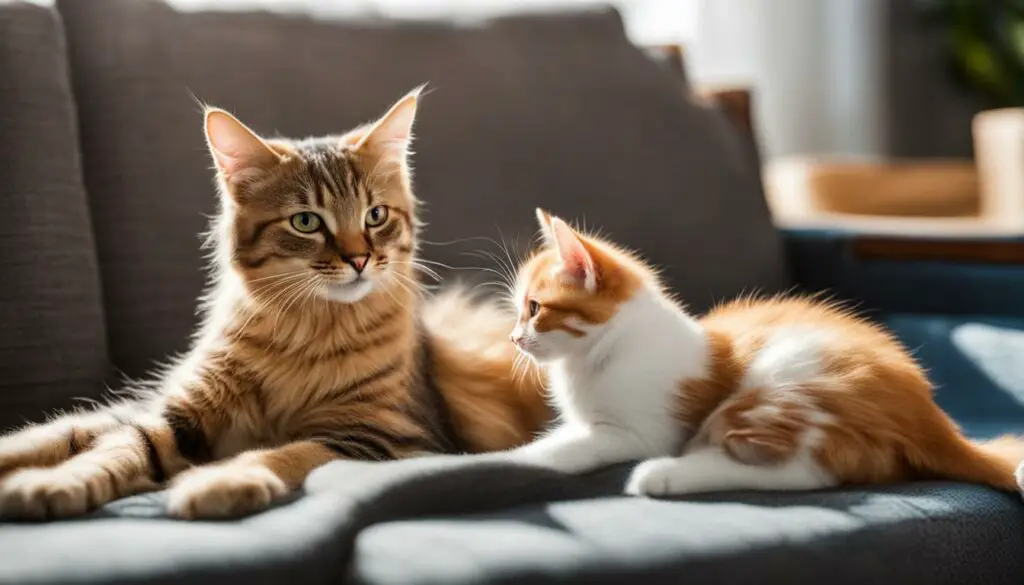Kittens and older cats can bring so much joy and companionship to a household. However, when a kitten starts playing too rough with an older cat, it can cause tension and potential conflict between the two feline friends. As a cat owner, it’s important to understand cat play behavior and learn how to manage and handle the situation effectively to promote a harmonious environment for both cats.
In this article, I will provide you with valuable insights on how to deal with aggressive play in kittens, prevent cat fights, and create a peaceful living space for your furry companions. Let’s explore strategies for managing cat play, introducing kittens to older cats, and promoting healthy play habits.
Key Takeaways:
- Understanding feline play behavior can help differentiate rough play from aggression.
- Meeting your kitten’s activity needs by providing regular play sessions and a stimulating environment can reduce rough play behavior.
- Redirecting play away from hands and feet, using interactive toys, and involving your kitten in the game can promote healthy play habits.
- Gradually introducing cats to each other, providing new objects for investigation, and considering adopting a playmate can help reduce rough play.
- If the rough play behavior persists, seeking professional help from a veterinary behaviorist or veterinarian may be necessary.
Understanding Feline Play Behavior
Cats engage in two types of play behavior: solitary play and social play. Solitary play refers to play directed towards objects, while social play involves interaction with other cats, people, or animals. Feline play behavior can sometimes include mock aggression, which may be mistaken for actual aggression when a kitten plays too rough with an older cat.
During solitary play, cats often chase, pounce on, and bat at objects such as toys or strings. This type of play allows them to develop their physical coordination and hunting skills. Social play, on the other hand, involves interactive play with fellow cats, people, or other animals. It is during social play that cats may engage in mock aggression, such as chasing and playfully biting one another.
“Cats’ play behavior is an important part of their development and overall well-being.”
It’s essential to understand that when a kitten plays too rough with an older cat, it is usually playful behavior rather than actual aggression. Kittens are still learning how to interact with others and may not have fully developed their social skills. As they grow older, they usually learn to moderate their play behavior. However, older cats may find rough play uncomfortable or overwhelming, which is why it’s important to manage and redirect their play appropriately.
By understanding feline play behavior and differentiating between mock aggression and actual aggression, we can implement effective strategies to promote healthy play and create a harmonious environment for both the kitten and the older cat.
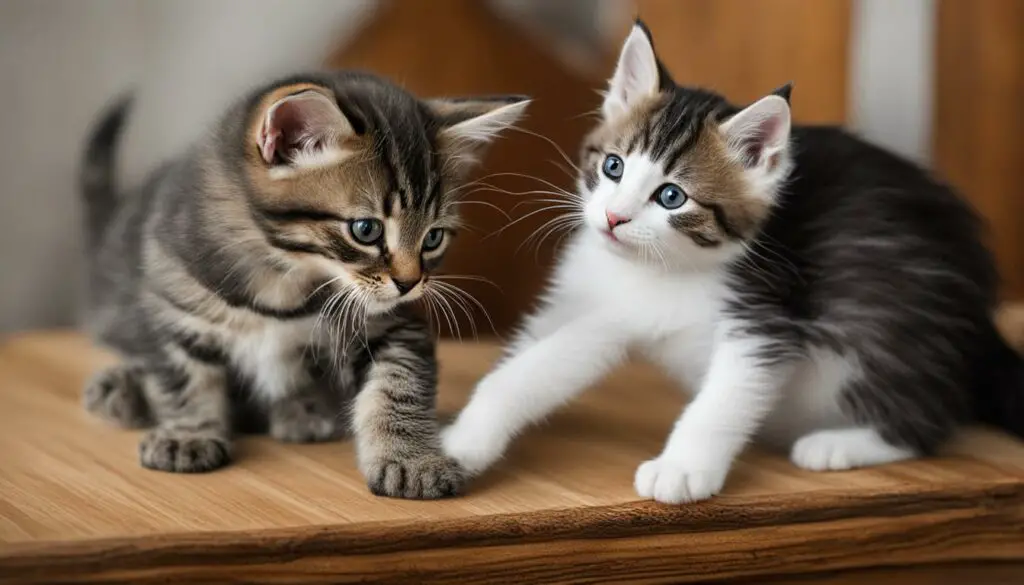
Reducing Rough Play Behavior
Managing rough play between a kitten and an older cat requires meeting the kitten’s activity needs and providing a variety of toys to keep them engaged. Engaging in regular play sessions throughout the day can help redirect their energy and reduce rough play behavior. It is important to create an active environment that promotes play and exploration.
When managing rough play, it can be helpful to have a schedule for play sessions that coincides with your cat’s most active times. This ensures that they have an outlet for their energy and reduces the likelihood of them seeking rough play with the older cat. Providing a variety of toys, such as interactive toys and puzzle toys, can also help keep them mentally stimulated and satisfied.
“Engaging in regular play sessions throughout the day can help redirect their energy and reduce rough play behavior.”
| Ways to Reduce Rough Play Behavior | Benefits |
|---|---|
| 1. Engage in regular play sessions with your kitten. | – Provides an outlet for their energy – Reduces the likelihood of rough play with the older cat |
| 2. Provide a variety of toys. | – Keeps them mentally stimulated – Satisfies their natural hunting instincts |
| 3. Create an active environment. | – Promotes play and exploration – Prevents boredom and frustration |
Additionally, it is important to observe the play sessions and intervene if the play becomes too rough. When the play escalates, you can calmly and gently separate the cats and redirect their attention to an appropriate toy or activity. This helps teach them what is acceptable play behavior.
By taking these steps to reduce rough play behavior, you can help create a more harmonious environment for both your kitten and older cat.
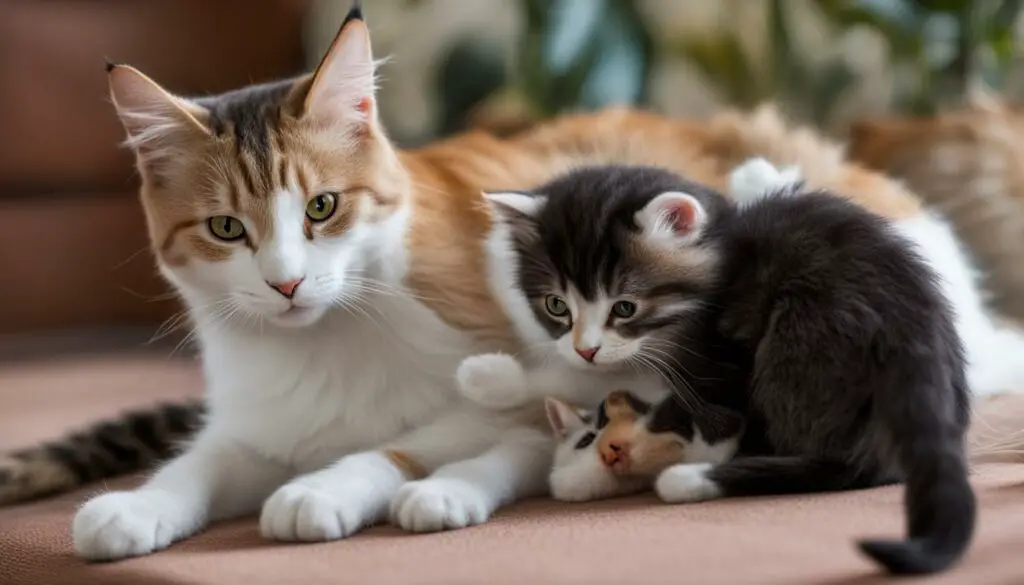
Tips for Promoting Healthy Play
When it comes to promoting healthy play between a kitten and an older cat, there are a few key strategies to keep in mind. One important tip is to direct play away from hands and feet. This helps teach your kitten that biting or scratching people is not acceptable behavior. Instead, use toys to engage in play with your kitten, providing them with an appropriate outlet for their energy and playfulness.
Another crucial aspect of promoting healthy play is understanding your cat’s body language. Pay attention to their signals and cues, such as tail movements and ear positions, to determine if they are in a playful mood or not. This can help you know when to engage in interactive play sessions and when to give them space.
Providing new objects for investigation is another effective way to promote healthy play. Cats are curious creatures, so offering them toys or objects that stimulate their senses can keep them entertained and engaged. Consider rotating and introducing new toys regularly to keep things interesting for your furry friends.
Adopting another cat as a playmate can also be a great way to promote healthy play. Cats are social animals and can benefit from the companionship and interaction with another feline. However, it’s important to introduce the cats gradually and ensure they are compatible before making this decision. A professional’s advice can be helpful in this process.
If you have the space and resources, creating an outdoor enclosure can provide your cats with additional opportunities for play and exploration. This allows them to experience the outdoors in a safe and controlled environment. Providing climbing structures, hiding spots, and interactive elements can make the enclosure even more stimulating for your cats.
Overall, promoting healthy play between a kitten and an older cat involves directing play away from hands and feet, understanding your cat’s body language, providing new objects for investigation, considering adopting a playmate, and creating an outdoor enclosure. By implementing these tips, you can help foster a positive and enriching play environment for your furry companions.
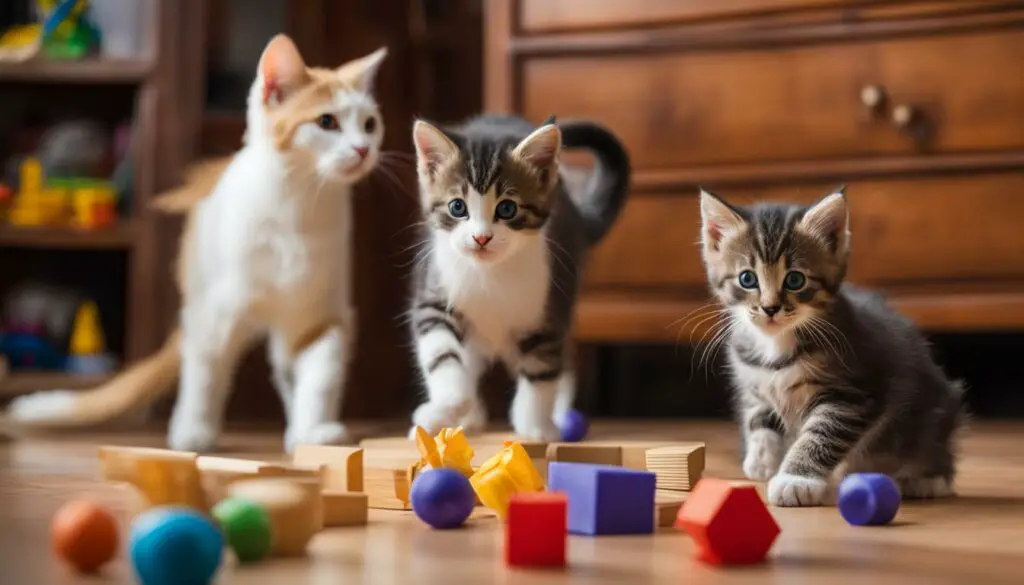
What Not to Do
When it comes to managing rough play between a kitten and an older cat, there are certain things you should avoid doing. By following these guidelines, you can help create a safe and positive environment for both cats:
- Avoid encouraging play with hands and feet: It’s important not to use your hands or feet as toys during playtime. This can confuse your cats and teach them that biting or scratching is acceptable behavior.
- Do not pet your cat during play: While it may be tempting to pet your cat while they’re playing, it’s best to avoid doing so. This can overstimulate them and potentially lead to rough play.
- Avoid toys that encourage play with hands: Choose toys that are safe and appropriate for your cats. Avoid toys that resemble hands or fingers, as they may encourage rough play behavior.
- Do not physically punish the cat: Physical punishment, such as hitting or slapping, is never an effective way to address rough play. It can damage the bond between you and your cat and lead to fear or aggression.
- Avoid yelling or squirting water: Yelling at your cats or using water as a punishment can cause stress and anxiety. It’s important to address rough play behavior in a calm and positive manner.
By avoiding these actions, you can promote a healthy and peaceful environment for your cats to play and interact with each other.
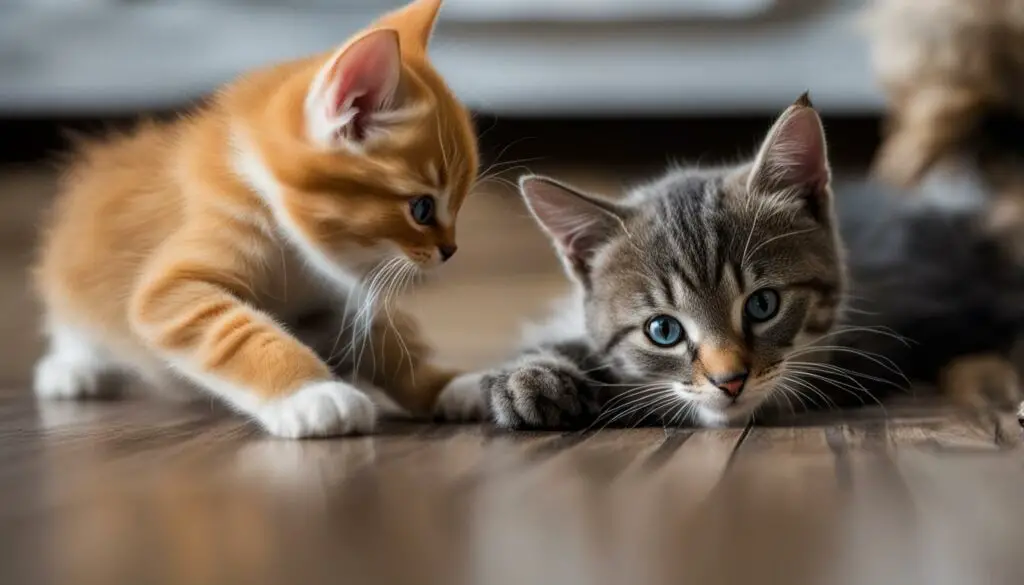
Short-Term Solutions for Rough Play
In situations where rough play becomes a concern between a kitten and an older cat, there are several short-term solutions that can help manage the behavior and promote a more harmonious environment. By implementing these strategies, you can prevent injuries and create a peaceful coexistence between your furry companions.
One effective method is to distract the cats during play. This can be done by introducing interactive toys or engaging them in a different activity that redirects their energy. By diverting their attention, you can help minimize rough play behavior.
Another approach is to separate the cats during aggressive play. If one cat becomes too rough or aggressive, it is important to intervene and create a physical separation. This allows both cats to calm down and prevents the situation from escalating further.
Additionally, it is crucial to introduce the cats gradually to each other. This process involves controlled interactions and supervised play sessions. By slowly acquainting the cats and allowing them to get used to each other’s presence, you can foster a more positive relationship and reduce the likelihood of rough play.
| Short-Term Solutions for Rough Play |
|---|
| Distracting cats during play |
| Separating cats during aggressive play |
| Introducing cats gradually |
Providing Interactive Toys for Play
When it comes to managing rough play behavior between a kitten and an older cat, interactive toys can be a valuable tool. These toys can help redirect your cat’s energy and provide them with both mental and physical stimulation. By engaging your kitten in the game, you can strengthen the bond between both cats and promote a positive and healthy play dynamic.
Interactive toys come in various forms, ranging from puzzle toys that require your cat to solve a challenge to toys that mimic prey movements. These toys can keep your cat entertained and satisfy their natural hunting instincts. By offering a variety of interactive toys, you can provide your cat with different experiences and prevent them from becoming bored or frustrated.
It’s important to spread your time between both cats during play sessions. This ensures that each cat receives equal attention and playtime, reducing the likelihood of conflicts over toys or attention. Additionally, supervising play sessions can help you monitor your cats and intervene if their play starts to escalate into rough behavior. By using interactive toys and managing playtime effectively, you can create a harmonious environment for both your kitten and older cat.
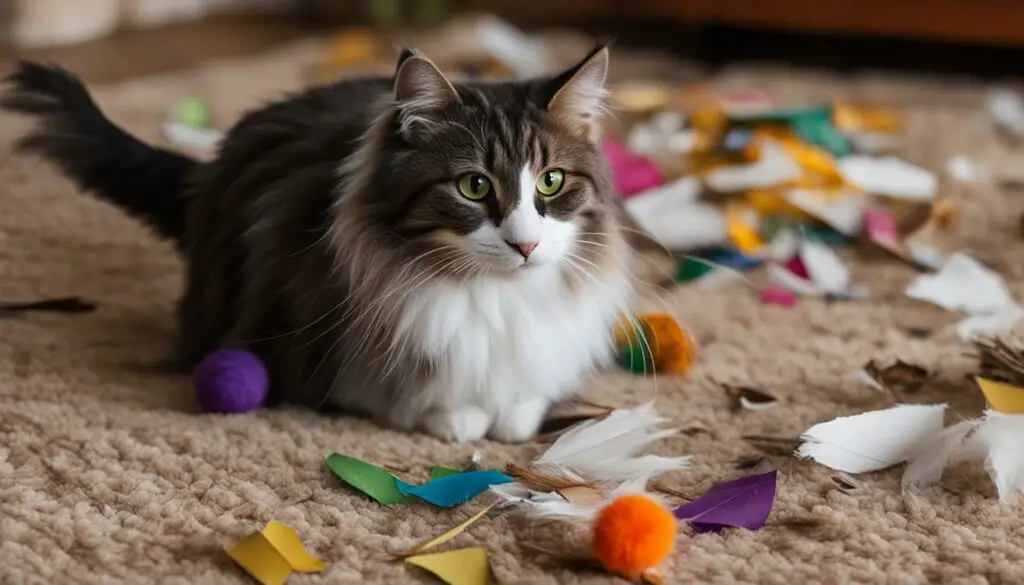
| Benefits of Interactive Toys for Cats |
|---|
| Provides mental and physical stimulation |
| Redirects energy into appropriate play |
| Helps strengthen bond between cats |
| Prevents boredom and destructive behavior |
| Offers a variety of play experiences |
Remember to choose interactive toys that are safe for your cats. Avoid toys with small parts that can be swallowed, and ensure that the toys are durable enough to withstand your cats’ play habits. Regularly inspect the toys for any signs of damage or wear and replace them as needed.
Using Time-Out for Rough Play
When rough play becomes too intense between a kitten and an older cat, it is important to intervene and establish boundaries. One effective strategy is to put the older cat into a time-out. This involves leaving the room during rough play to allow both cats to calm down and prevent further aggression. By removing yourself from the situation, the cats are given a chance to de-escalate their play and avoid potential conflict.
Consistency is key when using time-outs to manage rough play. It is important to be firm and enforce the time-out every time rough play becomes too intense. This helps establish a clear association between rough play and the end of playtime. With consistent time-outs, the cats will begin to understand that rough play results in the end of their fun, encouraging them to engage in more gentle play behavior.
Remember: Time-outs should be used as a means to redirect and discourage rough play, not as a form of punishment. The goal is to create a positive and safe environment for both cats to interact and play.
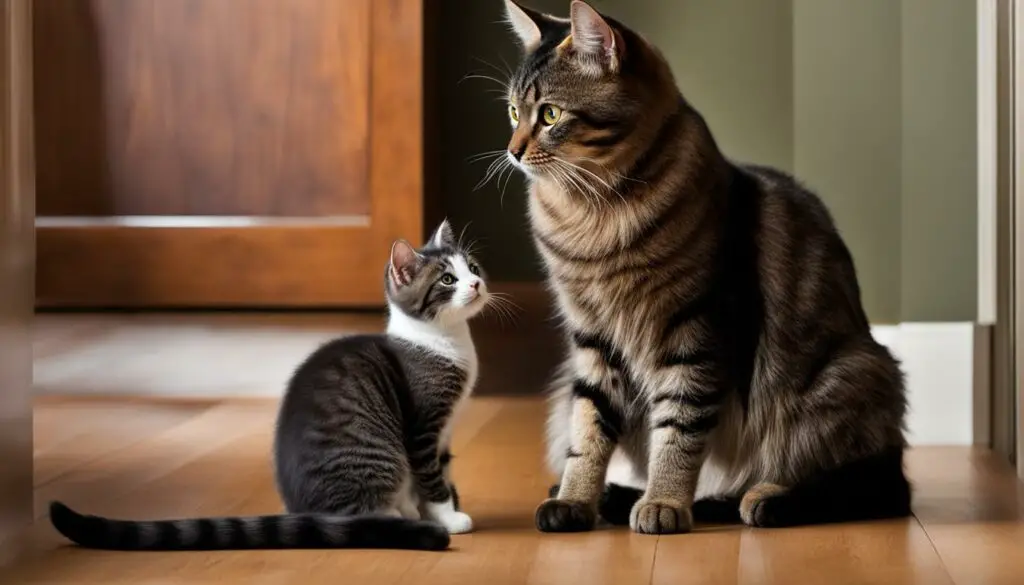
By implementing time-outs during rough play, you can help your kitten and older cat develop healthier play habits and promote a peaceful coexistence in your home.
Understanding Play Aggression
Rough play between a kitten and an older cat is often a result of mock aggression, which is a natural behavior for cats. When engaging in mock aggression, cats may exhibit hunting behaviors, such as pouncing and biting. It’s important to understand that this behavior is a form of play, rather than actual aggression. To manage rough play, it’s crucial to direct your cat’s play towards appropriate toys instead of using your fingers or hands.
Using cat toys instead of fingers or hands helps prevent your cat from associating play with biting or scratching human skin. By providing a variety of interactive toys, you can redirect your cat’s energy and stimulate their natural hunting instincts. Look for toys that mimic prey, such as feather wands or mice toys, to engage your cat in healthy play. Remember to reward desired behavior, such as playing well with appropriate toys, to reinforce positive play habits.
It’s also important to provide mental and physical stimulation for your cat. Interactive toys that require problem-solving, such as treat puzzles or puzzle feeders, can keep your cat engaged and mentally stimulated. Additionally, consider creating a play area with climbing structures, scratching posts, and hiding spots to provide an enriched environment for your cat.
“Play aggression is a natural behavior for cats and should be redirected towards appropriate toys. By using interactive toys and providing mental and physical stimulation, you can help reduce rough play behavior and promote a healthy play environment.”
Understanding Mock Aggression
Mock aggression can be a common occurrence in multi-cat households, especially when introducing a new kitten to an older cat. It’s essential to monitor their interactions and intervene when play escalates to prevent any potential harm. By using appropriate toys, rewarding desired behavior, and creating a stimulating environment, you can help your cats engage in positive play while reducing rough play behavior.
| Benefits of Using Cat Toys | Tips for Redirecting Play |
|---|---|
|
|
Understanding and managing mock aggression is crucial for promoting a harmonious relationship between your kitten and older cat. By using appropriate toys, providing mental and physical stimulation, and rewarding desired behavior, you can create a positive and engaging play environment for both of your feline companions.
Seeking Professional Help
If you have tried various strategies to address the rough play behavior between your kitten and older cat and nothing seems to work, it may be beneficial to seek help from a professional. Contacting a veterinary behaviorist or your veterinarian can provide expert guidance and advice for managing and correcting the behavior.
When seeking professional help, it is essential to communicate your concerns and observations about the rough play behavior. A veterinary behaviorist or veterinarian will be able to assess the situation and provide a personalized plan for behavior correction.
Remember, seeking professional help does not mean you have failed as a pet owner. Behavioral issues can be complex, and professionals have the knowledge and experience to identify underlying factors and develop effective solutions. They can also provide support and guidance throughout the behavior modification process.
Table: Contacting a Veterinary Behaviorist vs. Contacting a Vet for Advice
| Contacting a Veterinary Behaviorist | Contacting a Vet for Advice |
|---|---|
| Specializes in animal behavior and can provide in-depth assessments and behavior modification plans | Can offer general advice and guidance based on their experience and knowledge |
| Can diagnose and treat underlying medical conditions that may contribute to behavior problems | Can provide medical advice and rule out any medical causes for the rough play behavior |
| May conduct behavioral consultations and observe the cats in their environment | May provide recommendations based on the information provided and the cat’s medical history |
| Can offer long-term support and monitoring to ensure behavior modification is successful | Can provide follow-up appointments to monitor progress and adjust recommendations if needed |
Table

Distinguishing Rough Play from Aggression
When it comes to managing rough play between a kitten and an older cat, it’s crucial to be able to differentiate between playful behavior and actual aggression. By observing your cat’s body language and identifying signs of aggression, you can better understand their intentions and take appropriate action.
During play, it’s normal for cats to engage in activities such as chasing, pouncing, and wrestling. These behaviors are typically accompanied by a relaxed body posture, an erect tail, and soft vocalizations. However, if the play escalates into aggression, there are distinct signs to look out for. Ears turned toward the back, flattened body posture, growling, hissing, and aggressive swatting are indications that the interaction has crossed the line into aggression.
By closely observing your cat’s behavior, you can intervene before the situation escalates. If you notice signs of aggression, it’s essential to separate the cats and give them some time to calm down. This will help prevent any potential injuries and allow them to reset their behavior. Remember to be patient and consistent in your approach, as it may take time for the cats to learn appropriate play boundaries.
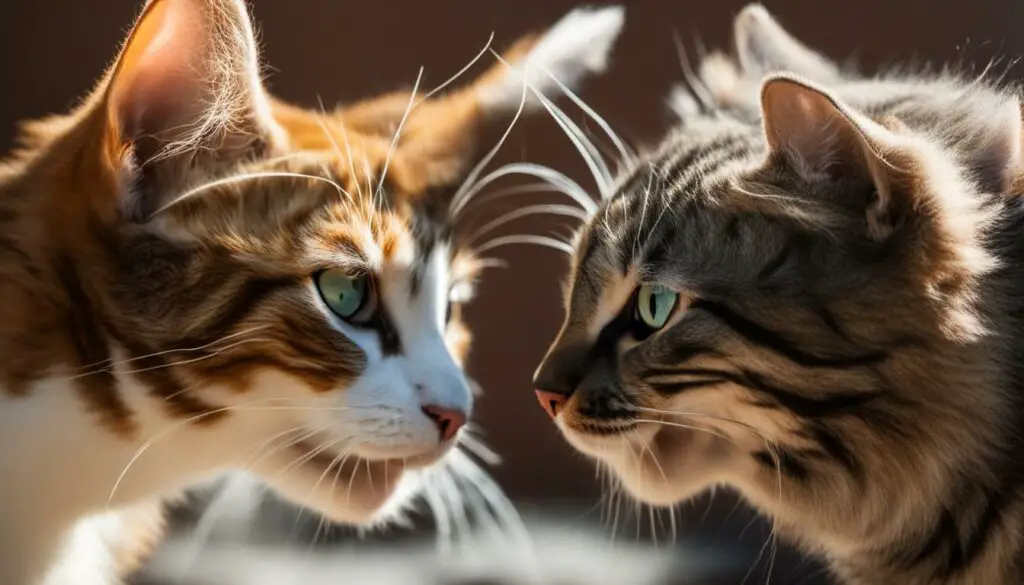
| Rough Play | Aggression |
|---|---|
| Relaxed body posture | Flattened body posture |
| Erect tail | Ears turned toward the back |
| Soft vocalizations | Growling or hissing |
| Playful chasing, pouncing, and wrestling | Aggressive swatting or biting |
Remember, it’s essential to always prioritize the safety and well-being of both your kitten and older cat. If you have any concerns about their behavior or are unsure how to handle a particular situation, consult with a veterinary behaviorist or your veterinarian for further guidance.
What to Do if Nothing Works
If you’ve tried various strategies to address the rough play behavior between your kitten and older cat and nothing seems to work, it may be time to seek professional help. Sometimes, the expertise and guidance of a board-certified veterinary behaviorist or an animal behaviorist can make all the difference in resolving the issue and promoting a harmonious relationship between your furry companions.
These professionals have extensive knowledge and experience in understanding feline behavior and can provide tailored solutions to meet the specific needs of your cats. They will assess the situation, identify any underlying causes for the rough play, and offer expert advice on how to modify and manage the behavior.
When seeking professional help, it’s important to contact a board-certified veterinary behaviorist or an animal behaviorist who specializes in cats. They will have the expertise and training necessary to address the complex dynamics of multi-cat households and provide effective strategies for resolving the rough play behavior.
Remember, seeking professional help is not a sign of failure – rather, it is a proactive step towards creating a peaceful and enjoyable environment for your cats. By working with a professional, you can gain valuable insights and guidance to address the rough play behavior and ensure a harmonious relationship between your kitten and older cat.
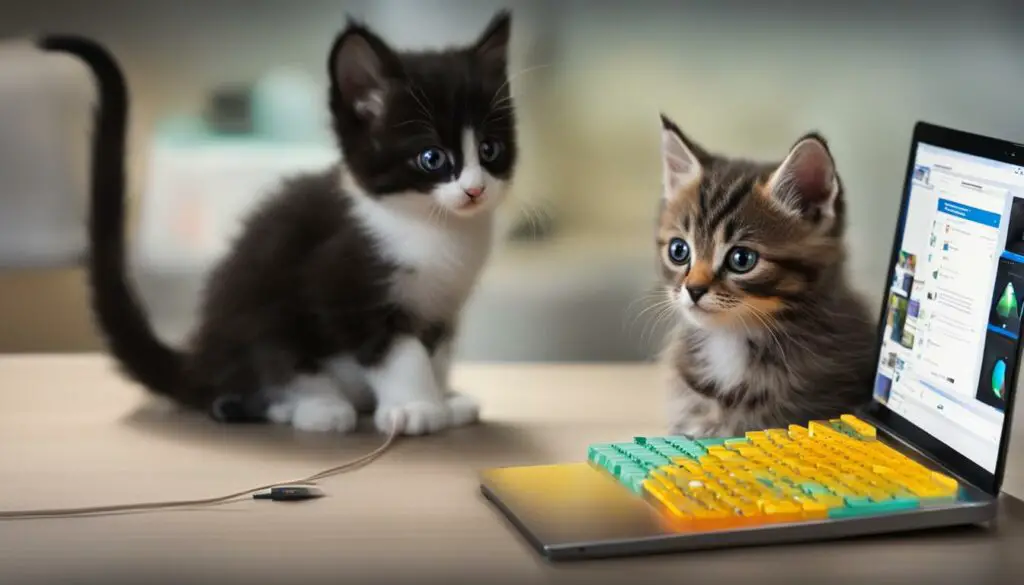
Table: Comparison of Board-Certified Veterinary Behaviorists and Animal Behaviorists
| Board-Certified Veterinary Behaviorist | Animal Behaviorist | |
|---|---|---|
| Training and Credentials | Extensive education and specialized training in veterinary medicine and animal behavior. Certified by the American College of Veterinary Behaviorists. | Varying educational backgrounds, ranging from biology and psychology to animal science. May hold certifications or credentials from professional organizations. |
| Expertise | Expert knowledge in both veterinary medicine and animal behavior, allowing for a comprehensive understanding of the physical and psychological aspects of behavior problems in cats. | Specialized knowledge in animal behavior, often focusing on behavior modification techniques and training methods. |
| Medical Considerations | Can assess and address any underlying medical issues that may be contributing to the rough play behavior. | Collaborates with veterinarians to address any potential medical causes for behavior problems. |
| Treatment Approach | Employs a combination of behavior modification techniques, environmental management, and, if necessary, medication to address behavior problems. | Uses behavior modification techniques and training methods to address behavior problems. |
| Follow-Up Support | Provides ongoing support and guidance throughout the behavior modification process to ensure long-term success. | May offer follow-up support, but the extent can vary depending on the individual behaviorist. |
Conclusion
Managing rough play between a kitten and an older cat can be challenging, but with the right strategies and understanding of feline behavior, it is possible to promote healthy play and create a harmonious environment for both cats. By meeting their activity needs, providing appropriate toys, and using positive reinforcement, you can help reduce rough play behavior and foster a positive relationship between your furry companions.
FAQ
How can I manage rough play between a kitten and an older cat?
To manage rough play, meet your kitten’s activity needs, provide a variety of toys, and engage in play sessions. Direct play away from hands and feet, understand your cat’s body language, and provide new objects for investigation. Consider adopting another cat as a playmate or creating an outdoor enclosure for more play opportunities.
What should I avoid when dealing with rough play?
Avoid encouraging play with hands and feet, refrain from petting your cat during play, and avoid using toys that teach your cat to play with your hands. Do not physically punish the cat or engage in yelling or squirting water, as it can create a negative relationship with your cat.
Are there any short-term solutions for managing rough play?
Yes, you can try distracting the cats during play, separating them during aggressive play, and gradually introducing them to each other. These strategies can help prevent injuries and create a more harmonious environment.
How can I promote healthy play between a kitten and an older cat?
Use interactive toys to redirect your cat’s energy and provide mental and physical stimulation. Involving your kitten in the game can strengthen the bond between both cats. It is also important to spread your time between both cats to avoid conflicts and ensure each cat receives attention and playtime.
What should I do if rough play becomes too intense?
If rough play becomes too intense, you may need to put the older cat into a time-out by leaving the room. This allows both cats to calm down and prevents further aggression. Be consistent with time-outs to reinforce that rough play will end playtime.
How can I differentiate between rough play and aggression?
Observing your cat’s body language, such as sideways hops or pounces, can help determine if it is playful behavior. Signs of aggression include ears turned toward the back and growling.
What should I do if nothing works to manage rough play?
If you have tried various strategies and nothing seems to work, it may be necessary to seek professional help. Contact a board-certified veterinary behaviorist or an animal behaviorist for expert guidance and advice.
Source Links
- https://www.hshv.org/rough-kitten-play/
- https://www.reddit.com/r/Pets/comments/6zuemk/new_kitten_too_rough_with_older_cat_need_advice/
- https://www.hepper.com/how-do-i-stop-my-older-cat-from-playing-rough-with-my-kitten/

